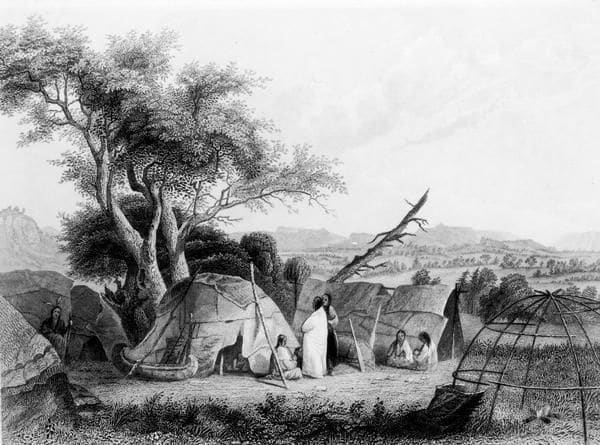The Winnebago tribe was a Northeast Indian Tribe that was located in northeastern Wisconsin close to modern-day Green Bay.
They were a powerful tribe in the region and dominated the western shore of Lake Michigan and the Upper Peninsula.
They would eventually fade as American expansion pushed them off their land. They are one of the federally recognized tribes and now reside in Nebraska.
Winnebago Tribe History
Winnebago oral history states they had always lived in their current homelands of Wisconsin, Minnesota, Iowa, Missouri, and Illinois. Their Siouan language indicates a common origin with other peoples of this language group. They state their ancestors built thousands of effigy mounds through Wisconsin and surrounding states during the Late Woodland period.
The tribe historically adopted corn agriculture at the end of the Late Woodland period, as well as hunting, fishing, and gathering wild plants. They cultivated wild rice and gathered sugar from sugar maple trees.
European contact came in 1634 with the arrival of French explorer Jean Nicolet. He wrote that the Winnebago occupied the area around Green Bay of Lake Michigan in Wisconsin, reaching beyond Lake Winnebago to the Wisconsin River and to the Rock River in Illinois.
The oral history also indicates that in the mid-16th century, the influx of Ojibwe people in the northern portion of their lands caused the Winnebago to move to the south of their territory. They had some friction with the tribes of the Illinois Confederacy as well as fellow Chiwere-speaking peoples splitting from the Winnebago. These groups, who became the Iowa, Missouri, and Otoe tribes, moved south and west because the reduced range made it difficult for such a large population to be sustained.
Nicolet reported a gathering of approximately 5,000 warriors as the Winnebago entertained him. Historians estimate that the population in 1634 may have ranged from 8,000 to more than 20,000. Between that time and the first return of French trappers and traders in the late 1650s, the population was reduced drastically. Later reports were that the Winnebago numbered only about 500 people.

When numerous Algonquian tribes migrated west to escape the aggressive Iroquois tribes in the Beaver Wars, they competed with the Winnebago for game and resources, who had to yield to their greater numbers.
The reasons given by historians for the reduction in the population vary, but they agree on three major causes: the loss of several hundred warriors in a storm on a lake, infectious disease epidemics after contact with Europeans, and attacks by the Illinois Confederacy.
The warriors were said to be lost on Lake Michigan after they had repulsed the first attack by invading the Potawatomi from what is now Door County, Wisconsin. Another says the number was 600. Another claim is that the 500 were lost in a storm on Lake Winnebago during a failed campaign against the Meskwaki, while yet another says it was in a battle against the Sauk.
Even with such a serious loss of warriors, the historian R. David Edmunds notes that it was not enough to cause the near elimination of an entire people. He suggests two additional causes. The Winnebago apparently suffered from widespread disease, perhaps an epidemic of one of the European infectious diseases. They had no immunity to the new diseases and suffered high rates of fatalities.
Winnebago's accounts said the victims turned yellow, which is not a trait of smallpox. Historians have rated disease as the major reason for the losses in all Native American populations.
Edmunds notes as a third cause of the population decline the following historic account: decimation by the Illinois Confederacy. The Winnebago had been helped at one time by many of their enemies, in particular the Illinois Confederacy, during their time of suffering and famine, aggravated by the loss of their hunters. The Winnebago then attacked the Illinois Confederacy. Enraged, additional Illinois warriors retaliated and killed nearly all the Winnebago.
After peace was established between the French and Iroquois in 1701, many of the Algonquian peoples returned to their homelands to the east. The Winnebago were then relieved of that pressure on their territory, and after 1741, most returned inland. From a low of perhaps less than 500, the population gradually recovered, aided by intermarriage with neighboring tribes and some of the French traders and trappers. A count from 1736 gives a population of 700; in 1806, they numbered more than 2,900.
A census in 1846 reported 4,400 people, but by 1848, there were reportedly 2,500. Like other Native American tribes, the Winnebago suffered great losses during the smallpox epidemics of 1757–58 and 1836. In the 19th-century epidemic, they lost nearly one-quarter of their population. Today, the total population of the Winnebago people is about 12,000.
Through a series of moves imposed by the U.S. government in the 19th century, the tribe was relocated to reservations increasingly further west: in Wisconsin, Minnesota, South Dakota, and finally, Nebraska.
Conclusion
The Winnebago tribe, like many other Native Americans, fell victim to disease and other Indian tribes. By the time that settlers began moving further west, the Winnebago tribe's numbers had dwindled substantially.
Most now reside in Nebraska or Iowa and operate a casino.
